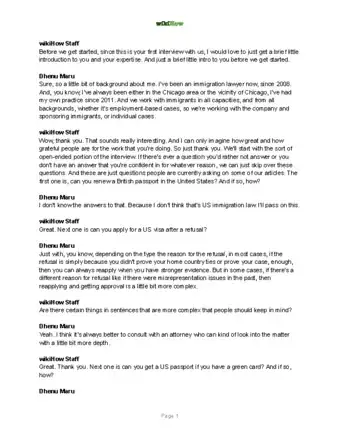This article was co-authored by Dhenu Maru. Dhenu Maru is an Immigration Lawyer, as well as the Founder and CEO of SwagatUSA, LLC. With over 10 years of experience, she specializes in family immigration and business immigration. She earned her law degree from Loyola University Chicago School of Law and her BA in Philosophy & Child Development from Tufts University. She was named a Rising Star by Super Lawyers for 2017, 2018, and 2019. She earned the title of Super Lawyer in 2021 and has been selected again for 2023.
wikiHow marks an article as reader-approved once it receives enough positive feedback. In this case, 100% of readers who voted found the article helpful, earning it our reader-approved status.
This article has been viewed 279,028 times.
Bringing your dog into the US can be a hassle, as a variety of information must be provided to get your dog clearance to enter. There are also special considerations to be made in terms of traveling, especially overseas, with a pet. The best way to assure the process goes smoothly is to have a thorough understanding of protocol as you prepare for your journey.
Steps
Making Travel Plans
-
1Make accommodations if you're flying. The majority of people who travel internationally do so via airplane. If you're planning on flying, and want to bring your dog with you, there are a variety of considerations you need to make.
- Your dog can travel in the cabin with you or underneath the airplane as cargo. Your pet is considered extra baggage and you will be charged according to the weight, including the pet's crate. On most airlines, your dog can only be taken as a carry on if his crate fits under the seat in front of you.[1]
- The only exception are trained service dog that are usually allowed to travel in the cabin.
- Different airplanes have different rules on shipping dogs. Some airlines might not allow dogs on board at all, regardless of breed and weight, so check with your airline to make sure your dog is allowed on the flight and you follow all protocol correctly. Most airlines do require that pets come with health certificates, no older than 10 days.[2]
- Some dangerous breeds, such as pitbulls, are restricted from traveling on certain airlines or from being imported into certain states. Check this information with the airline if you think there's a risk that your dog's breed may a be an issue.
- Acquire a travel crate. The airline requires the crate to be sufficiently large for the dog to be able to stand up inside and turn around.
-
2Consider a pet relocation service. If taking your dog with you via airplane is too inconvenient, or if your airline will not accommodate your dog, hiring a pet relocation service is another option. This can be quite costly, but might be worth the investment if typical airline shipping is not an option.
- Start talking to an agency well before your move. All regulations regarding international transportation must be adhered to by the relocation service and they need adequate time to plan. Two to three months in advance is the best way to assure your pet arrives in the US in time.
- Pricing varies, but is dependent on far more than just the weight of the dog. Other factors include the weight of the crate, the distance of the journey, the level of difficulty that comes with following regulations, and any other arrangements necessary to the dog's safe arrival. It might be difficult to get a cost estimate without scheduling several meetings with a representative.
Advertisement -
3Prepare your pet for travel. Travel is extremely stressful for pets, and adding the burden of an international journey can translate to disaster if your pet is not adequately prepared. In the months leading to your relocation, take steps to prepare your pet for travel.
- Crate train your pet before the journey. Dogs need to be familiarized with their crate and learn to associate it with positive feedback. If a crate is a part of your dog's day-to-day life under normal circumstances, it will mitigate the travel stress significantly. Start with putting food, water, and toys in a dog's crate and allowing her to come and go from the crate as she wishes. Shutting her in the crate while you are out of the house will teach her to accept being confined to it.[3]
- After 2 to 3 weeks, your dog should have calmed down about being in the crate at home. If your dog is small enough, it's ideal to be able to carry the crate from place to place with the dog in it. This desensitizes her to movement and minimizes the trauma of an airplane's motions. If your dog is too big to be carried, consider taking her on brief car trips in her crate.[4]
- Before you leave, clip your dog's nails. Dogs get nervous and might try to claw their way out of a carrier. They could easily snag or tear a nail, leading to bleeding, crying, and general distress.[5]
- Do not feed a dog in the 2 hours leading to a flight, and only feed him a light meal. You do not want your dog to urinate or defecate in his crate due to nervousness.[6]
- Keeping your dog's comfort in mind, aim to fly during a time of year that is not extremely hot or cold. Look for a flight with limited layovers.
Knowing the Regulations
-
1Get your dog a rabies vaccine and certificate. Rabies is one of the most important issues when it comes to overseas travel. The vast majority of the dogs who travel to the United States must have a current and valid rabies certificate. It should include all of the following:
- The name and address of the owner
- The breed, sex, age, and color of the dog
- The date of the rabies vaccination
- Products used for the vaccination
- The date the vaccination expires
- The name, license number, address, and signature of the veterinarian who performed the vaccination.
- The date of the vaccination can impact confinement periods. If the vaccination occurred less than 30 days before arrival, your dog will be confined for 30 days until it can be released to you. You are able to choose the facility where your dog will be confined.[7]
-
2Familiarize yourself with exceptions to rabies restrictions. While most dogs will need a rabies vaccine to be permitted in the US, there are some exceptions. Know what these exceptions are as you might be able to forego the certificate.
- If you have a puppy who is too young to be vaccinated, less than 3 months, you are permitted to take the dog into the country. However, the puppy will be confined until he can receive the vaccination and for an additional 30 days.[8]
- Some countries, like Australia, are rabies free. Due to the limited access to rabies vaccines in these countries, rules are different. Dogs are permitted to enter the US without the vaccination if the dog has lived there since birth or for at least 6 months. The dog will be required to receive the vaccine upon arrival and will be confined for 30 days.[9]
- If you're importing a dog for scientific research, and the presence of a rabies vaccine would interfere with that research, you can get the vaccination requirement waived.
-
3Learn about other special circumstances. In addition to rabies concerns, there are other issues surrounding international transportation of dogs. If you're traveling from certain countries, the US has special protocol for allowing your dog to enter.
- Screwworm, a parasitic fly known to infect dogs, is only present in certain countries. If your country contains screwworm, your dog will need a certificate from a licensed veterinarian declaring them screwworm free in order to enter the country. Your dog needs to have been inspected for screwworm within 5 days of entering the US.
- If you're from a country that's experienced Foot and Mouth Disease, you must take special considerations when bringing your dog to the US. Feet, fur, and bedding should be dirt free. Straw and hay should be eliminated from a dog's crate. Your dog should be bathed shortly after arriving in the US and kept separate from livestock for at least 5 days.[10]
- There are no separate regulations in regards to dogs being brought in the country for breeding or commercial purposes. You must follow all protocol even if the dog is not your pet.
Making the Trip
-
1Take a trip to the vet's office. Tell your veterinary you're planning on traveling to the United States. Book an appointment promptly, making sure you have enough time to procure test results. The following tests and procedures should be performed:
- Blood tests
- Vaccinations
- Microchips for identification purposes, if your vet can provide them
- After the exam, your vet should provide a Certificates of Veterinary Inspection to clear your pet for overseas travel.
-
2Include all necessary information on a pet's crate. When traveling with your dog, it's vital to include certain information his crate. This provides security on the off chance the crate is misrouted when changing flights.
- Include your pet's name and basic contact information for yourself. It's great to include email as, if you're traveling overseas, your phone might not work in the US.[11]
- Keep this secure on the crate with duct tape or other sturdy tape. If possible, have a sticker of the information made at a local print shop as this will stick more readily to the crate.[12]
-
3Prepare for customs. When traveling into the United States, you'll have to go through customs to get your pet cleared for entrance into the country. Prepare ahead of time to keep the process smooth and timely.
- Ensure that you have all the necessary medical information and permits required for entering the USA.
- In addition to having forms from your vet and proof of vaccination, you need to fill out the CPB Form 7501. This asks for basic contact information for you and a variety of questions about your dog. It can be downloaded from the website of your airline. Have a copy handy when approaching customs. If you're having your pet shipped as cargo, fax a copy and the other forms to the shipper.[13]
- Check the hours of operation at customs at your arrival port. You do not want to end up waiting overnight to get your pet home safe.[14]
- If you have all the proper paperwork, and your dog does not need to be confined, you should be cleared to enter the country.
Community Q&A
-
QuestionI have 2 small dogs that I want to take to San Francisco. They would be fine in one container. I wouldn't want them in cargo, but both with me. Is there any way that it could be arranged?
 Community AnswerYou'll have to check with your airline for their specific policy. They all have limits for how many animals can be in the cabin at a time, and they probably have individual policies regarding multiple animals in one container. They may also have specific requirements for the container, so ask about this as well.
Community AnswerYou'll have to check with your airline for their specific policy. They all have limits for how many animals can be in the cabin at a time, and they probably have individual policies regarding multiple animals in one container. They may also have specific requirements for the container, so ask about this as well. -
QuestionCan my dog travel in the cabin underneath while traveling from Chile to the USA if I have a letter from a psychologist stating that the dog is an emotional support animal?
 Έλενα Αρμαανίδη.Community AnswerYou have to first ask the company you want to travel with. If you have this kind of letter (especially from a psychologist), you generally can.
Έλενα Αρμαανίδη.Community AnswerYou have to first ask the company you want to travel with. If you have this kind of letter (especially from a psychologist), you generally can. -
QuestionCan a dog be shipped to USA on its own for its owner who lives over there?
 Community AnswerYou can book your pet on a separate plane, bring it with you, or through a commercial shipper.
Community AnswerYou can book your pet on a separate plane, bring it with you, or through a commercial shipper.
Expert Interview

Thanks for reading our article! If you'd like to learn more about bringing a dog into the United States, check out our in-depth interview with Dhenu Maru.
References
- ↑ http://www.state.gov/m/fsi/tc/c10442.htm
- ↑ http://www.state.gov/m/fsi/tc/c10442.htm
- ↑ http://www.whole-dog-journal.com/issues/17_5/features/Preparing-to-Fly-With-Your-Dog_20975-1.html?zkPrintable=1&nopagination=1
- ↑ http://www.whole-dog-journal.com/issues/17_5/features/Preparing-to-Fly-With-Your-Dog_20975-1.html?zkPrintable=1&nopagination=1
- ↑ http://www.whole-dog-journal.com/issues/17_5/features/Preparing-to-Fly-With-Your-Dog_20975-1.html?zkPrintable=1&nopagination=1
- ↑ http://www.whole-dog-journal.com/issues/17_5/features/Preparing-to-Fly-With-Your-Dog_20975-1.html?zkPrintable=1&nopagination=1
- ↑ http://www.foreignborn.com/visas_imm/entering_us/2bringyourpet.htm
- ↑ http://www.foreignborn.com/visas_imm/entering_us/2bringyourpet.htm
- ↑ http://www.foreignborn.com/visas_imm/entering_us/2bringyourpet.htm
- ↑ http://www.foreignborn.com/visas_imm/entering_us/2bringyourpet.htm
- ↑ http://www.pettravel.com/passports_container_requirements.cfm
- ↑ http://www.pettravel.com/passports_container_requirements.cfm
- ↑ http://www.state.gov/m/fsi/tc/c10442.htm
- ↑ http://www.state.gov/m/fsi/tc/c10442.htm
- ↑ http://hdoa.hawaii.gov/ai/aqs/animal-quarantine-information-page/
About This Article
To bring your dog into the United States, start by making sure your dog has a current rabies certificate from your vet. Additionally, check if you need other vaccinations, like Screwworm or Foot and Mouth Disease, to bring your dog to the US from the country you're coming from. Then, fill out CBP Form 7501 with information about you and your pet so you can clear customs. You should also prepare your pet's crate by labeling it with all the necessary information, like your pet's name, your phone number, and email address. For tips on how to book your dog onto a flight, keep reading!

































































